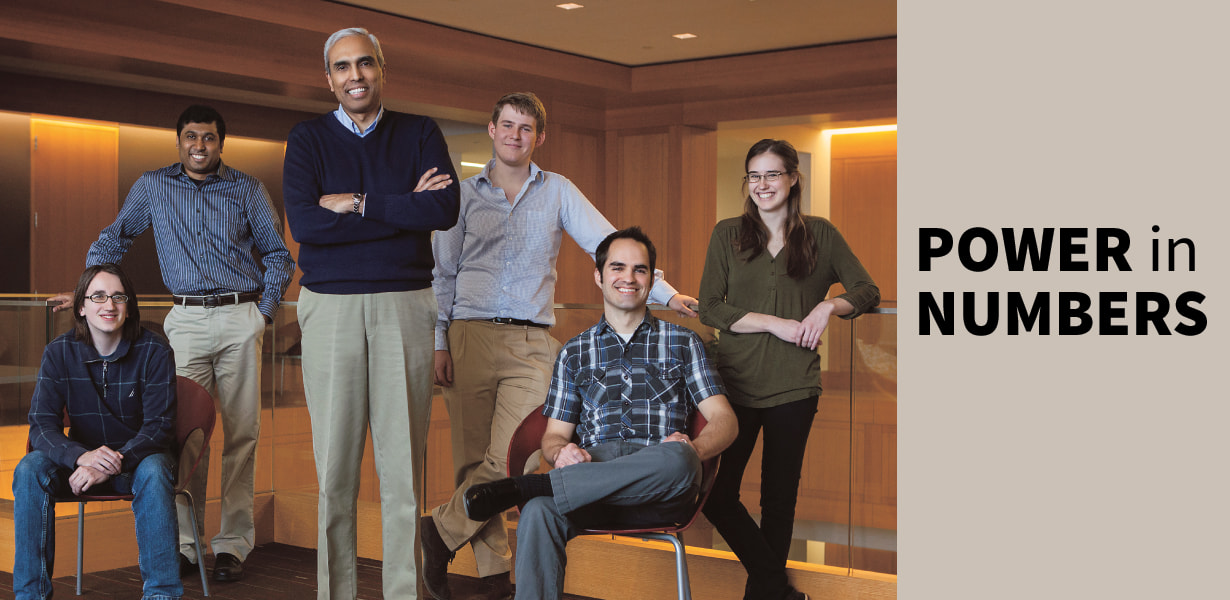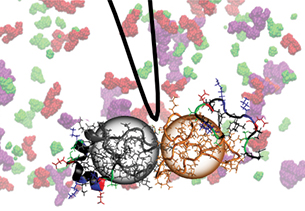Power in numbers
Rohit Pappu

While it takes a village to raise a child, it might also take one to develop a scientist – at least in the case of Rohit Pappu, PhD.
Pappu, who was installed as the Edwin H. Murty Professor of Engineering in March, can name every researcher he’s ever worked with over the course of his education and career as a … well, that’s hard to define.
“Someone recently asked me, ‘What are you? Are you a biophysicist? A physicist? A chemist? A physical chemist? An engineer? A computational scientist?’” Pappu recalls. “I said, ‘Yes ... and no.’ I’m not a biologist, but I know some biology. No self-respecting physicists would include me in their group. I have these core anchors, and they happen to be a polyglot of things.”
Regardless of his title, Pappu studies intrinsically disordered proteins and their role in neurodegenerative disorders such as Huntington’s disease, Alzheimer’s disease and Parkinson’s disease as well as age-related protein misfolding and aggregation. He also heads the Center for Biological Systems Engineering.

Pappu’s path to the Department of Biomedical Engineering in the School of Engineering & Applied Science in 2001 may not have been traditional, but he learned something from everyone with whom he worked as a graduate student, a postdoctoral researcher and as a faculty member. Those teachers included Nobel Laureates, physicists and scientists from varied backgrounds, his father and grandfather, and his students and trainees.
After earning a bachelor’s degree in physics, mathematics and electronics from St. Joseph’s College in Bangalore, India, Pappu came to Tufts University in Boston intending to study nonlinear optics to stay in the family business — his father was a researcher and professor of nonlinear optics at the Indian Institute of Science. While doing research, he came across a problem pertaining to diffusion he couldn’t solve and asked advice from the late David Weaver, who gave Pappu a stack of papers to read.
He noticed a common theme throughout — protein folding. He decided to write his doctoral thesis on developing computer simulation approaches to modeling aspects of the diffusion-collision model for protein folding.
After earning a doctorate in theoretical and biological physics from Tufts, Pappu wanted to continue working on computer simulations through postdoctoral research with Martin Karplus, PhD, now the Theodore William Richards Professor of Chemistry, Emeritus, at Harvard University and a 2013 winner of the Nobel Prize in Chemistry. Karplus and Pappu’s thesis mentor, Weaver, had developed the diffusion-collision model for protein folding, which was the first analytical theory for protein folding mechanisms. But Karplus was headed to Strasbourg, France, and Pappu was determined to stay in the U.S.
“I was on a visa at the time, and I thought that coming back from Europe to get employment in the U.S. would be difficult,” Pappu says. “That was pure naiveté. I will never live that down.”
But saying no to the prospect of working with a future Nobel Prize winner didn’t destroy his career. Pappu came to St. Louis to visit his father, who was living here at the time, and met with Jay Ponder, PhD, who was an assistant professor in the Department of Biochemistry at the School of Medicine.
“We got on like a house on fire,” Pappu says. “It was four hours of the most stimulating conversation I’d ever had. I was determined to work with him.”
“Some days I’m the teacher, some days they’re the teachers and some days we solve problems together.”
— Rohit Pappu, PhD
Another postdoctoral researcher who further shaped Pappu’s career came to work in Ponder’s lab at the same time. Enoch Huang, PhD, who had come from Stanford University, was attracted to Ponder’s lab for different reasons: Ponder had made important advances to the inverse folding problem. Given a sequence, one can either determine how that sequence folds, or given a fold, one can determine how many sequences will achieve that fold. Pappu’s conversations with Huang while working in Ponder’s lab began to catalyze his desire to work across disciplines.
“I started to notice that having to work on really hard biological problems, I was becoming a better physicist,” Pappu says.
With his eyes on a job in academia, Pappu wanted to get additional postdoc experience in a biophysics lab, so he went to Johns Hopkins University School of Medicine to work with another giant in the field, George Rose, PhD, professor of biophysics.
In Rose’s lab, Pappu focused on protein in its unfolded forms. This required an entirely different approach, and Pappu set out to learn all he could about polymer physics. Together, Rose and Pappu wrote two papers that uncovered a formalism for describing the conformational properties of unfolded proteins.
“One thing I did at Hopkins was read — up to 10 papers a day — and I would think,” he says. “I figured if I could keep indulging in the exposure, the language would sink in. I was a physicist muddling through biology, and eventually the light went on. That, to me, was the most shape-shifting period in my career.”
“It’s interesting that you can learn from people either because they teach you something and tell you exactly what to do, or you can learn from them because they know how to frame a problem, and they let you just be,” he says.
Yet another person would have influence on his life and career path just before he left Hopkins.
Keith Dunker, PhD, (now the director of the Center for Computational Biology and Bioinformatics; professor, Biochemistry and Molecular Biology and School of Informatics at Indiana University), gave a talk at Johns Hopkins. Dunker enlightened Pappu to the presence of proteins that have an intrinsic, sequence-encoded inability to fold into specific 3-D structures. Despite this inability, which suggests a negative connotation, these intrinsically disordered proteins are central to a variety of pathways that regulate several cellular decision-making circuits and outcomes. These proteins also are implicated in numerous complex diseases, including cancers, cardiovascular disorders and neurodegeneration.
Dunker sent Pappu a review of his findings, and Pappu narrowed his focus on what he wanted to study as an independent investigator at Washington University. He has since focused on connecting the information encoded in sequences of intrinsically disordered proteins to their conformational properties and the functions controlled by these apparently unusual molecules. He also has focused on the deleterious aspects of intrinsically disordered proteins, namely, the molecular basis of neurodegeneration in diseases such as Huntington’s disease and Alzheimer’s disease. He has pursued these interests since joining Washington University in 2001 as an assistant professor in the Department of Biomedical Engineering.
While Pappu continued to collaborate with high-profile scientists at WashU, including Carl Frieden, PhD, professor of biochemistry and molecular biophysics at the School of Medicine, his graduate students also began to influence his areas of research.
“I admire people who appreciate baseball because I live in a parallel universe where I could go on about cricket for weeks on end.”
“Andreas Vitalis totally changed my life,” Pappu says of the 2009 doctoral alumnus now at the University of Zurich. “At that point, I had yet to meet a person who I’d say in an unqualified manner is a genius, and he is a genius. He came up with a clever way of capturing the effects of solvent without explicitly modeling them. That totally changed the ballgame for us.”
Pappu also credits Scott Crick, PhD, Allen Chen, PhD, and Albert Mao, PhD, — all lab alumni — for their contributions to his research, as well as the postdoctoral researchers and students currently in his lab, including Rahul Das, PhD; Tyler Harmon; Alex Holehouse; Ammon Posey, PhD; and Kiersten Ruff.
“Some days I’m the teacher, some days they’re the teachers and some days we solve problems together,” Pappu says.
But he doesn’t always talk science with those in his lab — Pappu is an avid cricket fan. He’s been known to have Google chats in the wee hours of the morning with colleagues who are also fans of the English bat-and-ball game.
There are two other people who have influence on Pappu’s life, and they are his wife, Natasha, and daughter, Minerva, 15.
“My wife is my hero number one and my daughter is my hero number two. They keep me on the straight and narrow and remind me of what’s important, but so do the people I work with. These are phenomenal people.”
Back to Engineering Momentum